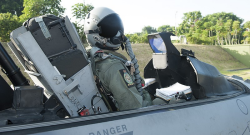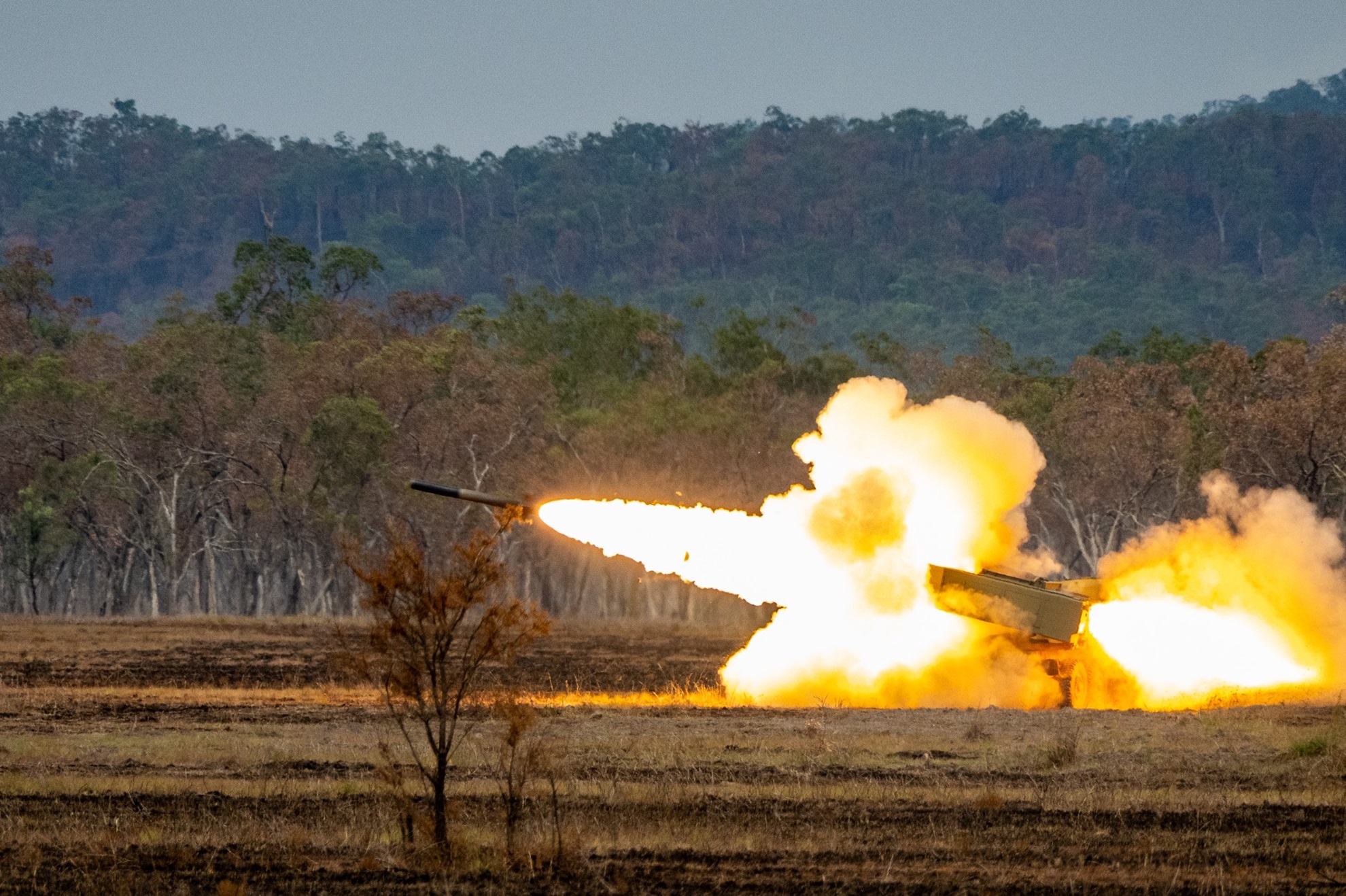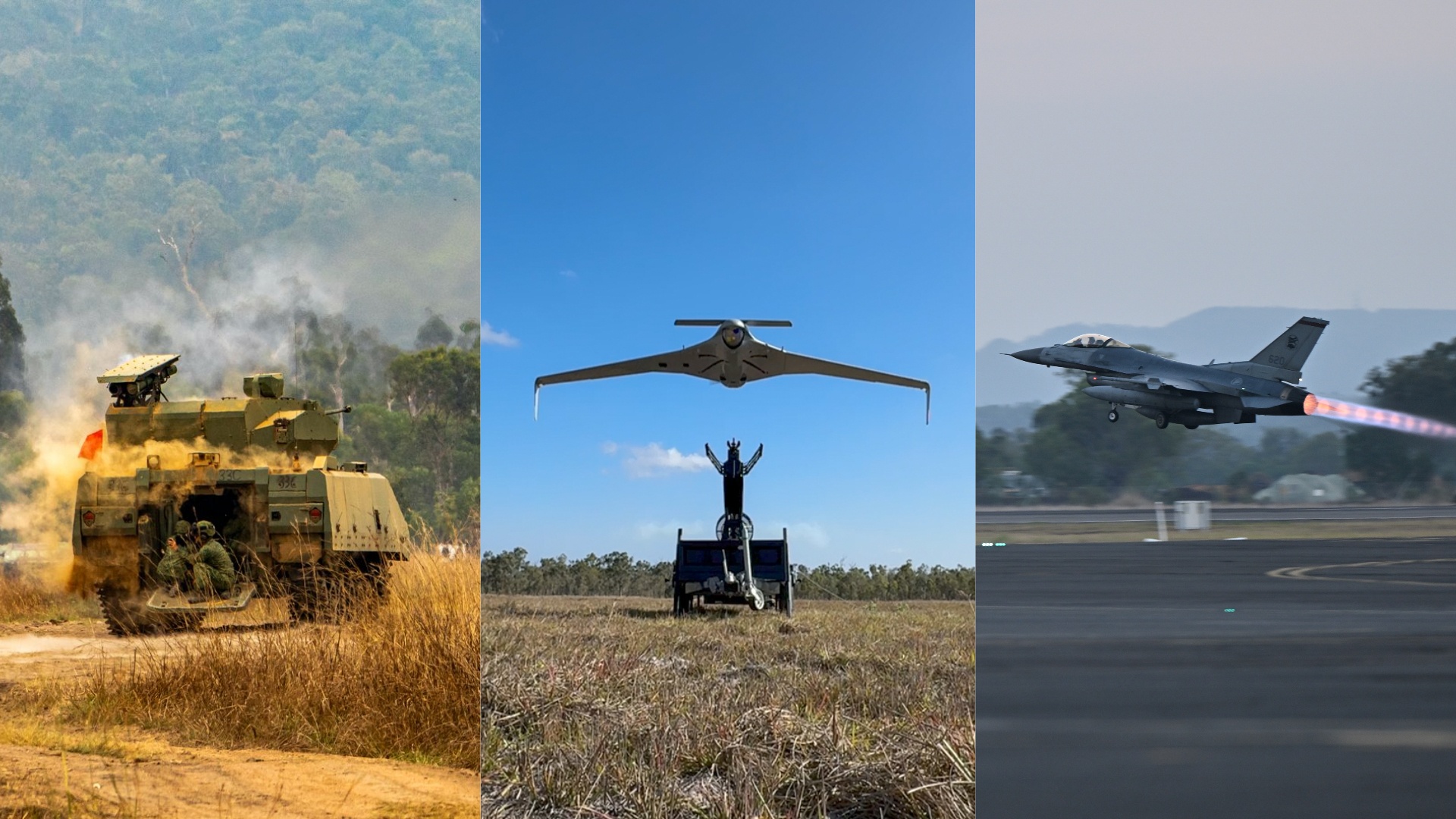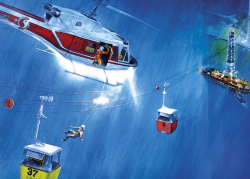OPS & TRAINING
FIVE FOR THE FLIERS
02 Sep 2013

Five stories spanning three decades of the Republic of Singapore Air Force (RSAF) which turns 45 this year. Five tales of how these aerial warriors overcame the challenges of everything from national crises to far-flung operations.
Ever Ready
Keeping watch
Something similar to the 9/11 incident could have happened in Singapore back in 2008. It was nearing the end of the work day on 22 Jan that year when Singapore air traffic controllers detected an unknown light aircraft heading towards the island nation.
Further checks showed that the aircraft did not have an approved flight plan. If it meant harm, the damage to densely populated Singapore could be severe. Loaded with explosives, even a light aircraft can blow a huge hole in the side of a modern building.
Communications with the pilot gave sketchy details. He reported an aircraft malfunction and originally wanted to land on the water within the Singapore Straits, but later changed his request to land in Seletar Airport instead, saying that an aviation company based there was supposedly waiting to receive the aircraft to carry out repairs.
However, checks with the aviation company did not tally with the pilot's story. That raised further alarm bells.
"We knew that we had to trigger our response mechanisms then," said Lieutenant Colonel (LTC) Chow Tze Meng. Trained as an Air Warfare Officer - Command, Control and Communications, he was on duty that Tuesday when the suspicious aircraft, later identified as a Cessna turboprop plane, was detected in Singapore airspace.
At 6.42pm, two armed RSAF fighter jets thundered off from Changi Air Base (East). Major (MAJ) Stanley Selva was at the helm of one of the F-16D+ fighter aircraft. "When we went out there, the weather wasn't ideal. We had to use our on-board avionics to detect the plane."
At the same time, Singapore's airspace was closed and Ground-Based Air Defence units got the errant plane in their sights. Once the pilots acquired the aircraft visually, they saw that it was a Cessna aircraft with pontoons for water landing and take-off. "If needed and given the instructions to fire, we would have blown him out of the skies in a matter of seconds," said MAJ Selva.
But it was too soon to pull out all the stops and their orders were simply to escort the errant plane to an airport. As he got nearer, MAJ Selva could make out the pilot in the cockpit. Previous communication with the Cessna pilot had only yielded more requests to land at Seletar Airport.
He then issued the warning: "You have been intercepted by Republic of Singapore Air Force armed fighters. You are to comply with instructions or risk being shot down."
The pilot's attitude "kind of softened up" after that, said MAJ Selva. The jets then escorted the Cessna aircraft to land at Changi Airport, where the police and civil aviation authorities took over. That day, Singapore s airspace was closed for 50 minutes.
The Cessna pilot, a 59-year-old Australian, was later fined $5,000 for flying without an airworthiness certificate. In passing the sentence, the civil court noted that the pilot did not have any malicious intent and had cooperated with investigations.
Protectors
Angel eyes
A vehicle lays immobile after being hit by a roadside bomb. The remaining troopers take up all-round defensive positions. The air drips with danger. An Unmanned Aerial Vehicle (UAV) circles overhead and its crew tell the troopers that the road ahead is clear of insurgents. The troopers can breathe easy again.
Welcome to Afghanistan in 2010 and the reality which the UAV Task Group had to face. They were deployed there for three months that year.
UAV pilot Lieutenant (LTA) Lester Cher recounted the incident where his UAV was diverted to an area where a coalition vehicle had been hit by an improvised bomb. "With the UAV overhead, the troops had additional 'eyes' in the air," explained LTA Cher.
Forces deployed to Afghanistan often found themselves the targets of ambushes, rockets and improvised explosive devices. These attacks, launched by insurgents living in the populace, meant that soldiers were under constant threat from an unseen enemy.
The UAV Task Group saved soldiers' lives by providing valuable information on ground conditions.
"The images provided by our UAV team gave our coalition partners more confidence," said LTA Cher. For example, the UAV could be sent ahead of patrols to map out safe approaches to buildings.
Twice-daily UAV flights provided the coverage which coalition forces needed and earned the praise of international forces. The Singapore deployment is vital to what we are doing. It provides overwatch for all of our soldiers every day. They are on time, on target every day," said COL (Ret) James Creighton, then Commander Combined Team Uruzgan.
Operating the Searcher UAV from Multinational Base Tarin Kowt, the team worked within Combined Team Uruzgan - a brigade-level command under the larger International Security Assistance Force - which was jointly commanded by the United States military and Australia Defence Force. The 52-strong UAV Task Group was the SAF's largest deployment in Afghanistan.
Said Military Expert (ME) 3 Chua Teck Hien: "I could feel the tension when we arrived in Afghanistan." Protective gear while outdoors was mandatory and rocket drills were a regular affair.
There were also other challenges. Deployed from a base which stood at 4,000 feet (about 1,200m) above sea level meant that the Searcher UAV was flying at much higher altitudes than it was used to. Sandstorms which shrouded the area also meant there were days when the team could not fly the aircraft.
When asked if he would go for a similar deployment, LTA Cher said: "Definitely. It's what we are trained to do. There is purpose in what we did; we made the world a safer place.
"Being in an operational deployment also made us sharper as a whole."
Lifesavers
Under the surface
In the murky waters 55m below, naval divers were combing the area for the two cars which had plunged into the waters. In all, seven people perished and 13 were rescued from four stranded cabins.
Following the incident, stringent safety regulations were imposed to prevent a similar tragedy. The all-night rescue operation was directed by then Colonel (now Prime Minister) Lee Hsien Loong. He was then the Chief of Staff (General Staff).
Rescue One One, Rescue One Zero
This headline may seem meaningless to most, but for the 13 people rescued from the 1983 cable car disaster, it meant the difference between life and death.
Rescue One One and Rescue One Zero were the call signs of the two RSAF rescue helicopters used to pluck holidaymakers stranded in their cable cars after the derrick of Eniwetok, a Panamanian-registered oil rig, struck the cable lines connecting mainland Singapore to Sentosa on 29 Jan that year.
The first helicopter was piloted by LTC (Ret) Kao Yit Chee, who was then a Lieutenant (LTA). The second had LTA (Naval) Geoff Ledger, who was seconded from the Australian armed forces, at the helm.
Back then, helicopters did not have auto-hover systems. That meant that pilots had to keep the aircraft steady in strong winds and near pitch-darkness while their colleagues were lowered down to the stranded cable cars.
Thirty years later, Senior Warrant Officer (SWO) Selvanathan Selvarajoo (then a Lance Corporal and a Winchman), remembers the rescue like it was yesterday. "This incident showed how our Air Force, even at that time, was capable of handling difficult situations that were maybe beyond our normal scope of operations."
Recalling the first cable car he entered, he said: "There was a man in shock. There were blood stains and everyone was unsure what to do. I told them to be calm." He rescued the three in the car one by one.
Then came the second car which was the closest to the oil derrick and had been badly damaged. It was dented, windows were smashed and chairs were broken. "When I opened the door, something fell out. It was part of a chair," said SWO Selvanathan, who is now Command Chief/Air Crew Specialist Leader, Heli Group, Participation Command.
From that car, he rescued Mr Jagjit Singh, who was then eight years old. The 38-year-old is now a director at an events company, with two children aged seven and 11.
"To be honest, my emotions about that day are still strong. I don't think they are printable," said Mr Singh. He said that not a day goes by without him thinking what might have been that day.
When it was his turn to be rescued, he refused to go not because he was afraid to step out into the pitch-black sky, but because he did not want to leave his family members behind. His cousin, being the youngest, was the first to be rescued. "I can only thank God and Mr Selva that I survived that day."
Aiders
Flights of mercy
How 116 Singapore soldiers had their training exercise turned into real operations in the aftermath of the February 2011 Christchurch earthquake is well documented.
However, not much has been said of the deeds of RSAF personnel involved in the New Zealand disaster relief operation. Less than a day after the earthquake struck, an RSAF KC-135R tanker flew more than 12 hours to bring an SAF command team and a 55-strong Singapore Civil Defence Force (SCDF) rescue team to the stricken city.
At the same time, two RSAF Hercules C-130 transport aircraft brought in rescue equipment. Limited by its range, the transport aircraft had to make two stops in Australia before landing in New Zealand.
The sheer amount of diplomatic clearances the RSAF had to obtain to make these flights possible was daunting. "Usually, these clearances can take up to a month to do," said Major (MAJ) Darrell Goh. He flew one of the two C-130 aircraft to New Zealand on 23 Feb 2011.
"But everyone stepped up," said MAJ Goh. From the time they received word that they were to be deployed, the team split up to carry out the various tasks like they were trained to do.
Navigators and pilots focused on how to get the aircraft to its destination, the ground crew and engineers readied the aircraft for flight and loadmasters contacted the SCDF to plan how to carry the load. When the C-130s took off at around 4am on 23 Feb 2011, the team had already worked through the day.
It took seven hours to reach an Australian air force base in Darwin to refuel and it was off to another base in Richmond, Australia, before the crew would get any rest. "Usually, we would stop at Darwin for crew rest. But because of the urgency of the mission, we decided to push on," explained MAJ Goh.
Over the next 11 days, the C-130 crew assisted the New Zealand Defence Force (NZDF) by airlifting close to 110,000 pounds (50,000 kg) of humanitarian aid and supplies, such as drinking water, decontamination equipment, clothing and portable generators, to victims of the earthquake.
The crew also helped to evacuate civilians to various parts of New Zealand and local search and rescue personnel into Christchurch to aid in relief efforts.
Air Crew Specialist 2nd Warrant (2WO) Officer Ng Kok Wee recounted an incident where he tried to help a New Zealander onto the KC-135R. He asked if he could help with a small pouch so as to free up her hands to make it easier to climb on board the aircraft.
She told 2WO Ng that she would prefer to keep the pouch with her, as it was all she had left after the quake and it contained her passport, among other important items.
"That was when it hit home that some of these people had really lost everything. It strengthened our resolve to help."
Integrated force
Fighting pirates from above
The narrow strip of water between Somalia and Yemen is known by many names. "Gulf of Aden" is one, "Pirate Alley" is another. Rampant pirate activity is the reason international forces converge on the area to conduct patrols and maintain open seas for all.
Since 2009, RSAF airmen have seen action in the Gulf of Aden five times under the ambit of Combined Task Force (CTF) 151.The first three deployments saw two Super Puma helicopters sailing with the Republic of Singapore Navy (RSN) Landing Ships Tank. In 2011, an RSAF Fokker-50 Maritime Patrol Aircraft detachment was also sent to provide maritime air surveillance.
The warship-helicopter combos worked well together. With the helicopters in the sky, the warships could "see" further and react faster.
On 1 Nov 2011, 1st Sergeant (1SG) (then 2SG) (NS) Given Tng came face to face with a pirate skiff (a small, fast vessel typically used to board ships). The warship RSS Endeavour had just foiled an attempted attack by pirates. The pirates were then ordered to return to their slower but larger mothership.
After the pirates abandoned the skiff, 1SG (NS) Tng fired upon the skiff from an RSAF Super Puma helicopter to sink it. This was done to prevent the vessel from being used in more pirate attacks. Trained as an Air Crew Specialist, the NSman currently works overseas.
In the 2012 deployment on board the frigate RSS Intrepid, Sikorsky S-70B pilots and air crew battled rough seas and sweltering daytime heat. "Trying to land (on the ship) in rough seas is like trying to put something down on a piece of jello which is in constant motion," said Major (MAJ) Chan Tze Yang, a Sikorsky S-70B pilot.
He recalled an incident where the helicopter was sent to investigate a distress call. A dhow which was being shadowed by three other ships had called the CTF 151. Those three ships were trying to corner the dhow by approaching it from different directions. On seeing the naval helicopter, the suspicious vessels turned away.
"It was good that we prevented a possible hostile situation," said MAJ Chan, who spent more than seven weeks on deployment.
In the ship's hangar, daytime temperatures could reach an oven-like 40 degrees Celsius. Up in the air, it could reach 37 degrees Celsius. "It was far beyond what we were used to back home," said MAJ Chan.
Working closely with the Navy was also crucial to success. While out in the Gulf of Aden, sailors had to make sense of the information which the airmen were pumping back from the Sikorsky S-70B's surveillance flights.
Said MAJ Chan: "The rapidly changing environment forced all of us to think on our feet. We re a sharper unit and I returned a better pilot because of this experience."
ALSO READ IN OPS & TRAINING

Exercise Wallaby 2025: To see better, shoot faster
31 Oct 2025
The SAF focuses on complex strike missions and multi-domain integration in Exercise Wallaby 2025, the 35th edition of its largest unilateral overseas exercise.

Ex Wallaby 25 – Greater Integration and Complexity
25 Oct 2025
The 35th edition of the SAF’s largest unilateral overseas exercise is an opportunity for expanded scale and deeper integration towards an effective, networked fighting force.

Ex Forging Sabre ramps up use of unmanned assets in integrated strike operations
12 Sep 2025
In this 10th edition of Exercise Forging Sabre, the SAF sharpened its cutting edge for the dynamic modern battlefield, with expanded integration between manned and unmanned platforms.






